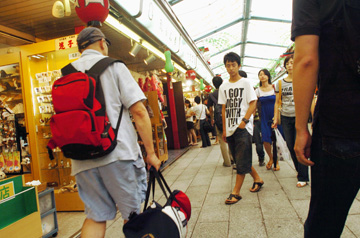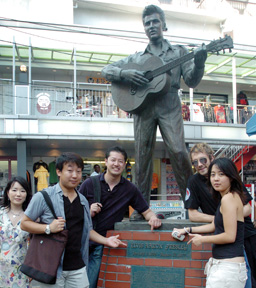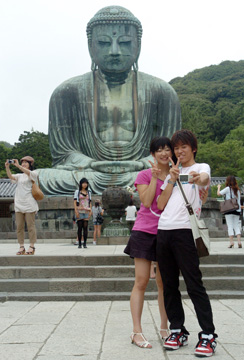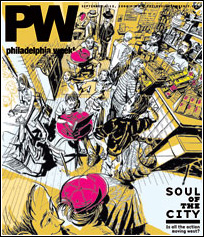Tokyo Prose
The language of Brotherly Love in the heart of Japan.
From the August 13, 2008 Philadelphia Weekly.
The lanky teenager struts past the stalls of cheap kimonos, screeching toys, rice-paper lanterns and plastic geisha wigs on Nakamise Street in Tokyo. His hair is purposely tussled. His expression reveals none of the joy you'd expect from someone sporting a T-shirt that reads, "I GOT JIGGY WITH IT."

The letters are bold and black, set against the white tee, looking like something from an old Wham! video.
I see this kid again and again over the next hour: praying in front of the vermilion shrine, stoically posing for pictures near the five-story pagoda, basking in the smoke from the giant incense burner that's supposed to ward off illness, and walking past the souvenir stalls again.
It's like he's mocking me, an apparition in modern, Philly-centric clothes, here in the Asakusa neighborhood, the historic heart of old Tokyo.
He's subtly telling me that everything I thought I knew about Japan is wrong: This is not the land of conformity and homogeneity, a world stubbornly set in its ways.
It's a land of contradiction.
***
Japan suffered from devastating civil wars during the 16th century with warlords battling constantly for land and power. One warrior, Ieyasu Tokugawa, finally subdued his rivals, and at the dawn of the 17th century Japan was at peace.
With the violence over, the country began to flourish.
People streamed into Tokyo, the nation's center of commerce. Money flowed into the city and the middle class was born.
To entertain the residents, kabuki theaters and sumo arenas opened, mostly here in the Asakusa district. Bawdy geisha houses roared with laughter and excitement. Samurai warriors painted pictures and wrote poems rather than slay enemies.
The city experienced more than 250 years of relative peace and prosperity and the arts and culture that grew out of that era was given a name: the floating world. It represents the surreal nature of existence, the ebullience of that enchanted era.
It seemed appropriate to use that name for the column I write for PW. Philadelphia is trying to end years of futile violence, and we have a burgeoning sense of civic pride that could be realized if only we eliminate our penchant for gratuitous crime.
***
Asakusa teems with people despite the 90-degree weather and stifling humidity that makes you feel like you're swimming in tepid water.
I look for traces of the old days, the archaic noodle houses and rustic sake shops where working-class stiffs drank away their nights 200 years ago. But all that was completely destroyed during American bombing in 1945.
The shrine that now stands is a sanitized exact replica of the one built 350 years ago. The neighborhood surrounding it is modern, and most buildings are austere concrete.
"If you came to Tokyo for the ancient stuff, you came to the wrong town," says Matt Hein, a 29-year old communications student at Temple University's Tokyo campus.
This city constantly reinvents itself, razing inefficient structures to erect high-rise towers and adding landfill to swampy areas in order to further expand.
There are now around 13 million people crammed into Tokyo, with more than 30 million in the metropolitan area.
They've mastered the ability to live en masse. You can ride the subway during morning rush hour and be so packed in that you're lifted off your feet. You won't fall down, and you won't get pick-pocketed.
It's a humbling experience.
***
We take the train to the Harajuku neighborhood to visit the shrine dedicated to the emperor who ushered Japan into the modern world in the late 19th century. The traditional shrine with 100-feet tall entry gates is set back in a dense forest. Thousands of people reverently march in near silence. The only sounds I hear are the shuffling of feet across the gravel path and the high-pitched buzzing of cicadas.
Immediately outside the park grounds, however, Harajuku becomes the raucous center of youth culture. Hyper-techno J-Pop blares from stores selling the latest fashions, teenagers squeal into cell phones, and street hawkers badger pedestrians to eat in their restaurants.
Some teens wear pastel dresses and blond wigs like anime characters, and others sport pink, spiked hair. There are Goths and kids with dreads, a few hipsters and a bunch of Paris Hilton wannabes - young girls in short, frilly dresses and oversized sunglasses, some with trucker hats on backward.
"In Tokyo, there's a scene for everything," says Mari Saito, a 20-year old Tokyo native who went to high school in New Zealand, attended Temple University in Japan for one year and now studies at the North Philly campus.
Saito escorts us to a store called Love Me Tender that features a life-sized bronze of the King in his Sun Records-era heyday. Inside, they sell old Elvis 45s, Elvis suits, Elvis movies and countless other Elvis collectibles.

On Sundays, the various subcultures crowd nearby Yoyogi Park.
"There are different groups of everything out there," Matt Hein tells me. "There are these rockabilly guys who sit around with their hair all slicked up and a bottle of Jack Daniels at their side. Every once and a while, they'll get up and dance to old Elvis songs."
Looking at them, you'd think it was 1956 all over again.
"Everyone will do their best to do their scene," Matt says. "You know - they're Japanese. They'll study the stuff and perfect it."
***
Tokyo is a dizzying place of dichotomies. Salarymen - office slaves who work 12-hour days - ride the subway reading sexually explicit manga. Electronic chirping bird sounds are piped into concrete subway tunnels. Rebellion only surfaces in a pack mentality.
"The surreal has become my everyday life," says Jon Cascarella, a South Jersey native and Drexel grad who moved to Japan 15 years ago.
You get used to seeing people who "GOT JIGGY WITH IT" walking past ancient-looking buildings.
"After six months," says Fishtown native Chris Brzozowski, a 16-year resident of Japan, "you'll want to stay here forever."









